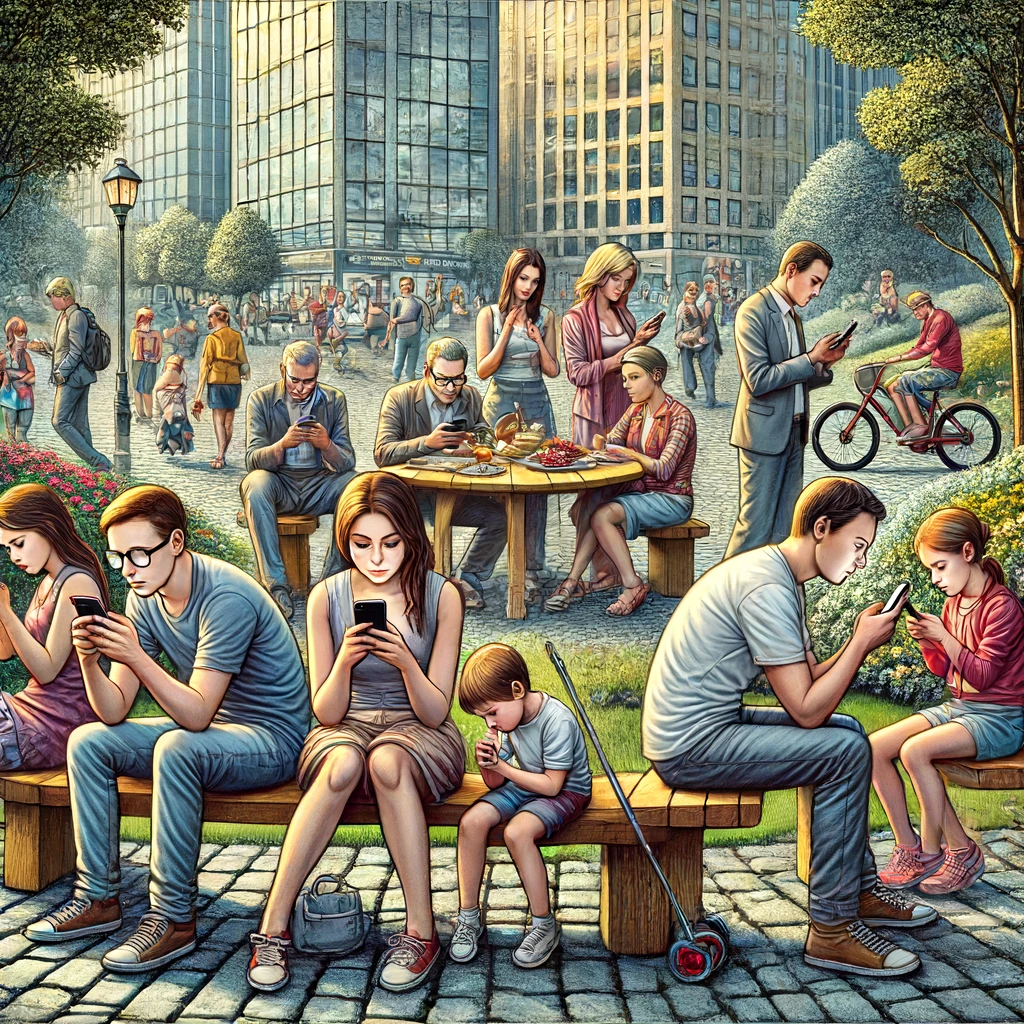I am sitting in a coffee shop, searching for inspiration, when it hits me: I’ll write about our current behaviours with communication technology and how they might shape our future interactions. Why? Because every person around me is on their phone. I wonder what they are using their devices for and if they are being productive or just killing time. Is this constant engagement with screens a glimpse into the future of human connection? Will our interaction with technology change the way we communicate with each other for good?
One thing is certain: everyone here who is glued to their phones is missing the chance to connect with others in the room. The days of accidental casual conversation or catching someone’s eye across the room seem almost gone. If this is the present state of affairs, the future of communication technology may alienate us even more from more authentic human interaction. Sure, new technologies will bring some amazing benefits, but only if we use them responsibly. If not, we will witness the erosion of human connection as we know it.
Exploring the Future of Communication Technology
If our current smartphone behaviours predict our future actions with communication technology, then we are in for an interesting future. From what I observe, we are mostly using current communications technology to engage in mindless scrolling. This is confirmed by research showing that a significant portion of smartphone use is dedicated to social media, gaming, and other non-productive activities.
Ideally, we should mostly use our smartphones for productive purposes, which include activities that enhance personal growth, efficiency, and well-being, such as using educational apps, managing tasks, connecting meaningfully with others, or staying informed through credible news sources. Non-productive use of our phones that involves excessive time spent on entertainment, social media, or gaming that does not contribute to personal development or fulfilment. This non-productive use of communications technology signals a future where we may be even more distracted and less connected to humans in a natural way.
Here are some suggestions for the kinds of communications technology we may see in the future, including a brief statement about the benefits and potential risks.
Holographic Communication
Imagine having holograms of people you’re talking to projected into your space, making virtual interactions feel almost as real as face-to-face meetings. This technology could enhance remote communication, making it feel more personal and engaging. However, it might also reduce face-to-face interactions, leading to feelings of isolation. It may lead to laziness; instead of going out to meet someone, you can just hologram them in from the comfort of your living room.
Brain-Computer Interfaces (BCIs)
These interfaces allow for direct neural communication, where thoughts can be transmitted without speaking or typing. BCIs could provide seamless communication and assistance for individuals with disabilities, offering new ways to interact with technology. Yet, privacy issues and the risk of mental fatigue from constant connectivity are significant concerns. The intrigue of not knowing what someone is thinking will be lost, and interactions could become awkward.
Augmented Reality (AR) Glasses
AR glasses overlay digital information onto the real world, allowing you to see text messages, video calls, or even social media updates without looking at a separate screen. While this can improve multitasking and provide useful information in real-time, it could also lead to constant distractions and blur the lines between digital and physical worlds. We might lose any prospect of human interaction if a person wears such a device in a coffee shop.
Universal Translators
These devices, already in production, provide real-time language translation, instantly translating spoken words into any language. They could break down global communication barriers, fostering greater understanding and collaboration. However, they might also reduce the incentive to learn new languages and diminish cultural appreciation.
Emotion-Sensing Wearables
These devices can detect and convey emotions through subtle vibrations or visual cues. They have the potential to enhance empathy and understanding in digital communication. On the downside, there’s a risk of misuse to manipulate emotions or invade emotional privacy. There is also the risk that humans will become less attuned to fellow humans in an authentic way.
Virtual Reality (VR) Social Spaces
VR social spaces are entirely immersive environments where people can meet, interact, and collaborate as if they were in the same physical space. This offers a sense of presence and interaction for remote teams or socially isolated individuals. However, overuse might lead to detachment from the physical world and neglect of real-world relationships. There is also potential for creating spaces that put humans in virtual situations far removed from their lived reality. Fantasy is fine until it warps into a reality for some users.
Advanced Voice Assistants
Already in operation, AI-powered assistants that can engage in more natural, context-aware conversations could enhance productivity and convenience. They provide assistance with daily tasks and improve accessibility. Nevertheless, they might also reduce human autonomy and critical thinking skills, leading to over-reliance on technology.
Telepathic Communication
Future developments in neuroscience might enable telepathic communication, allowing for thought transmission without speaking. This could revolutionise communication and understanding but poses risks to mental privacy and potential misuse for controlling thoughts. The idea of someone reading my thoughts is disturbing and may result in people learning to suppress thoughts. I can see an industry developing to create firewalls for human thought.
Gesture-Based Interfaces
Once again, systems that allow you to control devices and communicate through hand gestures, facial expressions, and body language are already in the early stages of production. These interfaces can make technology more accessible and intuitive. However, misinterpretation of gestures could lead to errors and frustrations.
Digital Twin Technology
Creating a digital twin of yourself that can attend meetings, interact with others, and perform tasks on your behalf could save time and increase productivity. However, issues with authenticity and the erosion of personal accountability are concerns.
Far-Fetched or a Real Possibility?
If you think some of this stuff is far-fetched, consider that Elon Musk is actively working on many of these technologies through his company, Neuralink. Neuralink focuses on developing brain-computer interfaces (BCIs) that facilitate direct neural communication, allowing humans to interact with computers and other devices using their thoughts. Neuralink: Elon Musk’s Brain-Computer Interface Company
Musk envisions a future where BCIs enhance human capabilities, improve the quality of life for individuals with neurological conditions, and integrate humans with artificial intelligence. His ventures in AI, through companies like OpenAI, and his interest in augmented reality and other advanced technologies highlight his commitment to pushing innovation in communication.
Dumb Use vs Smart Use
There is a risk that these technological advancements may contribute to greater distraction and reduced real-life interactions is we are dumb users. On the other hand, used sensibly, future technologies could amplify positive outcomes if we use the technology for learning, productivity, and meaningful connections.
We already know that unproductive smartphone use contributes to reduced productivity, mental health issues like anxiety and depression, physical health risks from poor posture and eye strain, and sleep disturbances due to blue light. On a societal level, it weakens face-to-face interactions, reduces community bonds, causes economic losses from decreased productivity, leads to public safety issues from distracted driving, and affects academic performance due to excessive phone use. Smartphone Use and Mental Health: A Review
Those who use these advancements in communications technology productively will reap the benefits and thrive, while the mindless scrollers will become more disturbed, alienated, and mad. Retaining what it means to be human will always mean genuine human connection, exercise and time in nature, sleep, and good nutrition.
Will We Become Zombies?
The potential for increased desensitisation is a real concern. As people become more immersed in digital and virtual environments, there is a risk of becoming desensitised to real-life human interactions and emotions.
This desensitisation can stem from several factors:
Virtual Reality and Violence
Exposure to violent content in virtual reality (VR) and augmented reality (AR) games or experiences could potentially desensitise individuals to violence.
Social Media
Constant exposure to distressing news, graphic content, and online bullying on social media platforms can lead to emotional numbness.
Reduced Face-to-Face Interaction
As digital communication replaces face-to-face interactions, people may lose some of their ability to empathise with others, potentially leading to increased antisocial behaviours. How Smartphones Affect Productivity in the Workplace
Evolutionary Changes: Potential Pros and Cons
We know that animals evolve as their environment changes, so could the same happen to humans? As communication technology advances, humans could undergo fascinating evolutionary changes biologically and culturally. Here are some potential evolutionary outcomes:
Less Need for Human Interaction
As digital communication becomes more immersive and satisfying, humans might evolve to require less face-to-face interaction. We might become more content with virtual relationships, leading to reduced social skills and empathy.
Enhanced Cognitive Abilities
Integration of BCIs might lead to improved memory, faster information processing, and heightened problem-solving skills. However, this could also lead to mental overload and dependency on technology.
Advanced Sensory Perception
As AR and emotion-sensing wearables become commonplace, humans might develop more refined sensory perceptions. Yet, this might cause sensory overload or detachment from natural perceptions.
Telepathic Communication
Neural interfaces could enable more efficient and accurate thought-sharing, leading to deeper empathy and collective understanding. However, this poses risks of invasion of mental privacy and ethical concerns.
Physical Adaptations
Increased use of gesture-based interfaces and VR could result in more dexterous fingers and improved hand-eye coordination. However, prolonged use could lead to physical strain or health issues.
Cultural Evolution
Universal translators could lead to a more unified global community, blending diverse traditions into new, hybrid cultural norms. The downside is the possible loss of linguistic diversity and cultural uniqueness.
Emotional Intelligence
Emotion-sensing technology could drive the evolution of heightened emotional intelligence. Yet, this comes with potential manipulation of emotions and privacy concerns.
Social Structures
Digital twins could shift social structures towards more flexible and dynamic lifestyles. However, this raises issues of authenticity and dependence on digital proxies.
Reduced Language Dependency
AR and VR could make communication more visual and intuitive, reducing reliance on spoken language. However, this could lead to decreased verbal communication skills and literacy.
Conclusion
Smartphones are powerful tools that can significantly enhance our lives when used wisely. The key is to be mindful of how we use our devices and make conscious choices to engage in productive activities. By doing so, we can harness the power of technology to improve our lives rather than allowing it to become a source of distraction. The future will require greater discipline and awareness of how we interact with emerging technologies to ensure they enhance our connectivity and productivity rather than diminish them. Reflecting on our current use of smartphones, we can speculate about the future of communication technology. Are we on the path to becoming smarter users, or are we setting ourselves up for increased distraction and disconnection? Ultimately, how we use technology today will shape the communication landscape of tomorrow. Therefore, it is crucial to strike a balance between embracing technological advancements and preserving the essence of human connection.
FAQs
What are the main concerns about future communication technologies?
Future communication technologies raise concerns about privacy, mental health, and the potential for reduced real-life human interactions.
How might holographic communication impact social interactions?
Holographic communication makes remote interactions more personal but also reduces face-to-face meetings, leading to isolation.
What are brain-computer interfaces, and what are their implications?
Brain-computer interfaces enable direct neural communication with devices, offering new interaction methods but raising privacy and mental fatigue issues.
Will augmented reality glasses enhance or harm our social interactions?
AR glasses can improve multitasking and information access but might lead to constant distractions and reduced real-life social interactions.
How can universal translators affect cultural diversity?
While universal translators can foster global communication, they might reduce the incentive to learn new languages, potentially diminishing cultural appreciation.
What role do emotion-sensing wearables play in communication?
Emotion-sensing wearables can enhance empathy and understanding in digital communication but also pose risks of emotional manipulation and privacy invasion.

